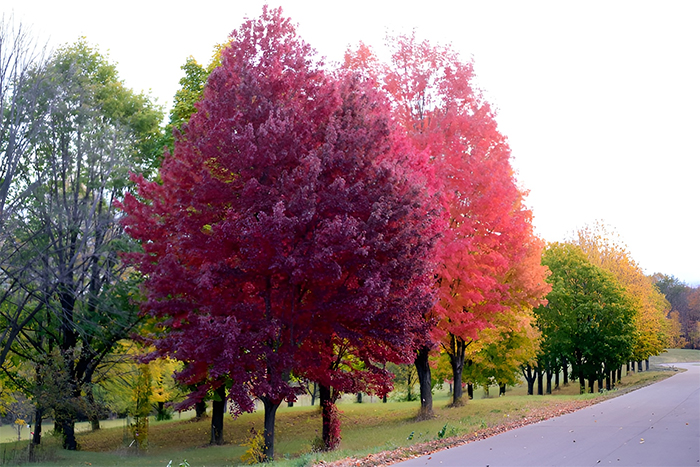The science behind Minnesota’s fall colors
News | Published on October 7, 2025 at 2:44pm GMT+0000 | Author: Tucker Henderson
0
‘Brandywine’ red maple trees located along Peter C. Moe Drive at the University of Minnesota Landscape Arboretum.
By University of
Minnesota Arboretum
Special to the Forum
In Minnesota, autumn offers a brilliant, fleeting transition between the sweltering days of summer and the long, cold nights of winter. For a few magical weeks each year, crisp air carries the scent of fallen leaves across the state, with maples ablaze with crimson and oaks radiating a golden hue.
As both a scenic escape and a hub of horticultural research, the University of Minnesota Landscape Arboretum offers the perfect vantage point to explore what makes Minnesota’s array of fall colors so dazzling and dynamic.
So, why do leaves change color in the fall? And why are some years more spectacular than others?
Minnesota’s autumn palette
“Shorter days and cooler temperatures signal trees to prepare for winter by conserving energy and water,” explains Eli Sagor, University of Minnesota Extension forestry specialist and professor at the University of Minnesota’s Cloquet Forestry Center. And according to Jessica Savage, associate professor and plant physiologist at the University of Minnesota Duluth, this process leads chlorophyll, the culprit behind the green hue of deciduous plants, to break down.
In many species, leaf color change is due to the loss of chlorophyll, which reveals colors that were previously masked by the green, such as yellow, brown, or orange. Yellow and orange leaf colors come from carotenoid pigments, which are always present in leaves and break down more slowly than chlorophyll, says Laura Irish-Hanson, an Extension horticulture educator based at the arboretum.
But some species accumulate anthocyanins, pigments that produce red or purplish hues. Their production depends on high sugar levels in the leaves, which are boosted by sunny, warm days and retained by cool nights that slow down sugar transport.
When this ideal weather combination occurs, trees are more likely to show vivid reds. Without it, red pigments may not develop. According to Irish-Hanson, the two biggest factors influencing a tree’s autumn color scheme are shortening day length and declining temperatures. But the process begins long before the leaves start to change.
Eli Sagor said that a warm, wet spring will set the best stage for a brilliant fall. “Adequate rainfall throughout the summer, especially late in the season, keeps leaves healthy, supporting brighter yellows, oranges, and reds.”
Climate change is already reshaping this delicate process, however.
According to Brandon Miller, assistant professor of horticultural science and curator of plant collections at the arboretum, the unpredictable and extreme weather caused by climate change can delay and dull the intensity of fall leaf color.
Sagor confirms that warmer weather can delay the start of color changes, making leaves stay green longer, shortening the timing window for vibrant foliage, and dulling its intensity. Sagor also said drought-stressed trees often produce fewer pigments, even when a drought hits early in the growing season. On the other hand, he notes that excessive rainfall can cause early leaf drop or even kill sensitive species. Overly warm fall nights can also interfere with anthocyanin production, resulting in less vivid reds and purples. As a result, autumnal colors may arrive later, fade faster, and lose some of their brilliance.
Still, nature keeps us on our toes. “Some plants may exhibit more intense color changes when stressed,” says Irish-Hanson.
But the most reliable recipe for spectacular fall foliage remains the same: a healthy growing season followed by sunny days and crisp autumn nights.
For local color cues, follow the arboretum on social media and watch Minnesota DNR’s Fall Color Finder (dnr.state.mn.us/fall_colors) for weekly updates on fall color throughout the state.
This story was adapted from the University’s Arboretum magazine.
